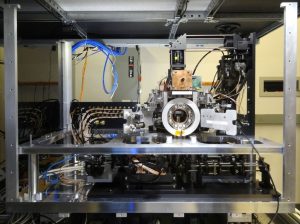We have designed and constructing universal quantum processors that use long chains of 171Yb+ ions as our qubits. The systems have a read/write head of up to 32 detection channels and individually addressable laser control beams with minimal crosstalk. Ions natively support all-to-all connectivity via a global data bus that sends quantum information through the vibrational modes of the ion chain. We have demonstrated high-fidelity two-qubit and single-qubit native operations that can be compiled to create a universal gate set capable of implementing any quantum circuit.


Our primary research focus is on the understanding and mitigation of errors, including the implementation of an error-corrected logical qubit. Our main building block for quantum error correction is the Bacon-Shor-13 code, consisting of 9 data qubits, which hold an arbitrary quantum state in a distributed manner, and 4 ancilla qubits, which are used to stabilize the quantum state and detect errors. We additionally plan to execute a range of quantum algorithms with a system size and gate depth that move beyond what has previously been demonstrated. Furthermore, the individual control of our system enables exploration of new quantum many-body physics phenomenon such as phase transitions or hybrid digital-analog quantum systems.
Methods
 We use a chip trap developed by Sandia National Laboratories that enables precise control over our ion chains. With 100 electrodes on the surface, the electric potential above the trap surface is engineered precisely to achieve shuttling and merging of ions to deterministically build up long chains or to provide individual qubit readout in the middle of a quantum algorithm. The high optical access design allows small laser beam widths at each individual ion for individual addressing of our qubits with minimal cross-talk.
We use a chip trap developed by Sandia National Laboratories that enables precise control over our ion chains. With 100 electrodes on the surface, the electric potential above the trap surface is engineered precisely to achieve shuttling and merging of ions to deterministically build up long chains or to provide individual qubit readout in the middle of a quantum algorithm. The high optical access design allows small laser beam widths at each individual ion for individual addressing of our qubits with minimal cross-talk.

With this system, we can manipulate ions either individually or collectively with full control over Raman drive frequency, amplitude, and phase. We create evenly spaced laser beams that are focused on the ions using a 32-channel AOM designed by L3-Harris. The detection light from each qubit is collected on an array of 32 fibers for fast individual readout. Entanglement is performed by applying two high power laser beams to the target ions for a specific amount of time. Optimizing the shape of these pulses results in the creation of a pure two-qubit entangled state useful for quantum computation with minimal error.
System Integration and Automation
This experiment was designed from the top down with industry collaborators to be a tightly integrated system. It is enclosed in an environmentally isolated box, with motorized control over all required degrees of freedom. As the number of qubits grows, it is a challenge to maintain precise control over an increasing parameter space. With this ion trap system, we aim to have the system automatically calibrate itself and run user submitted jobs when ready. To this end the system can actively stabilize ion positions, Raman beam alignment, and motional mode frequencies based on ion measurements without user input. The control system is based on the open-source ARTIQ software. The system automatically loads 15-ion chain in ~2 minutes (limited by thermal source warmup) with near-unity success probability.

